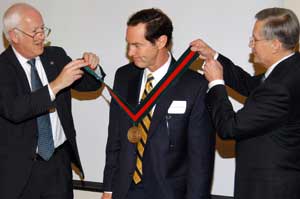Bruce H. Haughey, M.D., director of the Division of Head and Neck Surgical Oncology and professor of otolaryngology was installed last month as the first holder of the Dr. Joseph B. Kimbrough Chair in Maxillofacial Surgery and Prosthodontics in the Department of Otolaryngology for Teaching and Healing.
Haughey also is a researcher with the Siteman Cancer Center and a head and neck surgeon at Barnes-Jewish and St. Louis Children’s hospitals.

The position was made possible by a bequest from Dr. Joseph B. Kimbrough, an 1894 graduate of the University’s College of Dental Medicine. Kimbrough served on the dental school faculty and maintained a successful private practice for 61 years. He died in 1963 at the age of 93.
Chancellor Mark S. Wrighton and Larry J. Shapiro, M.D., executive vice chancellor for medical affairs and dean of the School of Medicine, announced Haughey’s appointment.
“Dr. Kimbrough’s generous gift to his alma mater will support our efforts in oral and facial reconstructive surgery and prosthodontics for those suffering the ravages of cancer,” Wrighton said. “His bequest will be a great assistance in retaining and attracting superior faculty for this important program so strongly rooted in dental medicine at Washington University.”
Shapiro said, “Many of the sophisticated procedures now being used in this field could not even be considered in Dr. Kimbrough’s era, and we believe we honor Dr. Kimbrough’s memory through this forward-looking and life-enhancing work.
“Bruce Haughey’s research and practice help people resume normal living after often devastating surgical procedures and embody both compassion and innovation.”
Haughey has been with the School of Medicine since 1988. As director of the Division of Head and Neck Surgical Oncology in the Department of Otolaryngology, he oversees a multidisciplinary group of specialists who treat patients with all forms of head and neck cancer, including thyroid and skin cancers.
Clinical trials conducted in the division use new therapies to eradicate these cancers paired with the latest reconstructive techniques to restore voice, communication, swallowing and appearance. The surgeons have pioneered a number of minimally invasive and reconstructive procedures including reconstruction of the tongue, facial soft tissue (lip, cheek, forehead or nose), voice box and skull base.
Precise radiation targeting and minimally invasive endoscopic laser surgery techniques have also been developed to markedly enhance patient survival, recovery and well-being.
Recent investigations by Haughey have focused on the difficult task of reconstructing areas of the pharynx, esophagus, mouth and tongue after surgery to remove cancerous tissue.
Haughey and his colleagues have been notably successful in reconstruction of the tongue after partial or complete removal.
Haughey led a study of patients who received tongue reconstruction, in which tongue tissue was replaced with tissue from the patients’ forearms or thighs and constructed using a special folding technique developed by Haughey and his colleagues.
After reconstruction, most patients were able to swallow and speak intelligibly, and the results exceeded those of studies by other groups.
Haughey earned undergraduate and medical degrees from the University of Auckland in New Zealand, graduating in 1976 from the medical program. He was an intern at Waikato Hospital in Hamilton, New Zealand, and then became a trainee under the auspices of the Royal Australasian College of Surgeons in surgery and otolaryngology at Auckland Hospitals until 1981.
He then moved to the United States and furthered his study of otolaryngology and head and neck surgery at the University of Iowa Hospitals and Clinics. In 1984, he completed a fellowship in skull-base surgery at the same institution and earned a master of science degree in otolaryngology from the University of Iowa.